
|
Statewide News |
Northern California
|
Southern California |
FAQs & Upcoming Events |
Building High-Speed Rail for California with Support from our Federal Partners
 One of the main focuses for the Authority in 2023 is building upon our partnerships with the federal government to deliver California’s high-speed rail program. The Authority is uniquely positioned to immediately deploy new federal funding investments that will supplement current state funds toward the delivery of the initial high-speed rail line between Merced and Bakersfield and to advance design on crucial segments in both Northern and Southern California.
One of the main focuses for the Authority in 2023 is building upon our partnerships with the federal government to deliver California’s high-speed rail program. The Authority is uniquely positioned to immediately deploy new federal funding investments that will supplement current state funds toward the delivery of the initial high-speed rail line between Merced and Bakersfield and to advance design on crucial segments in both Northern and Southern California.
The Bipartisan Infrastructure Law (BIL), passed last year, is a once-in-a-generation investment in our nation’s infrastructure, including passenger rail. There is more than $75 billion in new and increased funding eligible for passenger and freight rail projects through discretionary grant funds. The Authority has developed a grant strategy to best leverage available state matching funds to maximize federal awards and put a priority on advancing work in the Central Valley, to date, we have targeted $8 billion in new federal awards across several federal programs over the next five years.
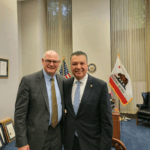 In April, the Authority applied for two applications from the Federal State grant program totaling more than $3 billion in federal funding for the nation’s first high-speed rail project. The applications are a major push for a continued federal partnership under the BIL. As part of that effort, we received support from more than 150 elected officials, regional, state and national organizations and labor leaders. That support included, 29 members of the California Legislature, 34 members of Congress and both California U.S Senators, two former U.S. Secretaries of Transportation, Governor Gavin Newsom and former Governor Jerry Brown. More about our federal grant applications can be found here.
In April, the Authority applied for two applications from the Federal State grant program totaling more than $3 billion in federal funding for the nation’s first high-speed rail project. The applications are a major push for a continued federal partnership under the BIL. As part of that effort, we received support from more than 150 elected officials, regional, state and national organizations and labor leaders. That support included, 29 members of the California Legislature, 34 members of Congress and both California U.S Senators, two former U.S. Secretaries of Transportation, Governor Gavin Newsom and former Governor Jerry Brown. More about our federal grant applications can be found here.
The Authority also recently sponsored and participated in the national U.S. High-Speed Rail Conference in Washington D.C. during Infrastructure Week (May 15 – 20). Authority CEO Brian Kelly and Director of Sustainability Meg Cederoth participated in various panels on the project with experts from around the U.S. and the globe. In addition to participation in the conference, members of the executive team also met with members of the California congressional delegation, Speaker Emerita Nancy Pelosi, US Senator Alex Padilla, Mitch Landrieu, Senior Advisor to the President, executives from the US Department of Transportation and Federal Railroad Administration.
As we contmake our way through 2023, we will continue to work with our federal partners to ensure that we are building a high-speed rail project that will benefit Californians as soon as possible.
Authority Recognized as Employer of the Year for Advancing Women’s Careers in Transportation
 Earlier in May, the Authority was honored to receive the 2023 WTS Recognition Award – Employer of the Year from the international chapter of the Women’s Transportation Seminar (WTS). The recognition caps a series of regional “Employer of the Year” awards for the Authority by the Sacramento, Los Angeles and San Francisco Bay Area WTS chapters over the past 18 months. The Authority was recognized for exemplary efforts to encourage advancement of women’s careers in the transportation sector, which historically has predominantly employed men. More than half of the Authority’s total workforce is female – as well as most of the executive team, many appointed under the Newsom Administration. Major initiatives and programs led by women at the Authority include strategic delivery; legal counsel; strategic communications; legislative affairs; information technology; planning and sustainability; administration and human resources; diversity, equity and inclusion; engineering; and regional leadership. Read more about this award.
Earlier in May, the Authority was honored to receive the 2023 WTS Recognition Award – Employer of the Year from the international chapter of the Women’s Transportation Seminar (WTS). The recognition caps a series of regional “Employer of the Year” awards for the Authority by the Sacramento, Los Angeles and San Francisco Bay Area WTS chapters over the past 18 months. The Authority was recognized for exemplary efforts to encourage advancement of women’s careers in the transportation sector, which historically has predominantly employed men. More than half of the Authority’s total workforce is female – as well as most of the executive team, many appointed under the Newsom Administration. Major initiatives and programs led by women at the Authority include strategic delivery; legal counsel; strategic communications; legislative affairs; information technology; planning and sustainability; administration and human resources; diversity, equity and inclusion; engineering; and regional leadership. Read more about this award.
ICYM: New Construction Update Out Now!
 In mid-May, the Authority released its Spring 2023 Construction Update highlighting continued progress on the nation’s first high-speed rail project. Highlights include the completion of the Cedar Viaduct located in Fresno. The Cedar Viaduct is most notable for its double span of arches that span over State Route (SR) 99. The structure is nearly 3,700 feet long and will take high-speed trains travelling at 200-plus mph over SR 99, North and Cedar avenues. The Construction Update also highlights the recent completion of structures in Kings and Kern counties and progress on other signature structures like the Conejo and Hanford viaducts. Since the start of construction, the Authority has created more than 10,000 construction jobs, with a majority going to residents from the Central Valley. View the update here. Haga clic aquí para la versión en Español
In mid-May, the Authority released its Spring 2023 Construction Update highlighting continued progress on the nation’s first high-speed rail project. Highlights include the completion of the Cedar Viaduct located in Fresno. The Cedar Viaduct is most notable for its double span of arches that span over State Route (SR) 99. The structure is nearly 3,700 feet long and will take high-speed trains travelling at 200-plus mph over SR 99, North and Cedar avenues. The Construction Update also highlights the recent completion of structures in Kings and Kern counties and progress on other signature structures like the Conejo and Hanford viaducts. Since the start of construction, the Authority has created more than 10,000 construction jobs, with a majority going to residents from the Central Valley. View the update here. Haga clic aquí para la versión en Español
| UPDATES FROM NORTHERN CALIFORNIA |
The City Wonders What’s Next for Downtown, and How Transit Will Help
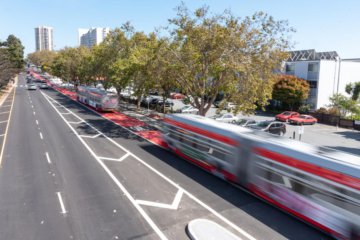 As a result of the COVID-19 pandemic, public transportation ridership dramatically declined around the country. Workers, for the most part, stayed home for the first year or two of the pandemic.
As a result of the COVID-19 pandemic, public transportation ridership dramatically declined around the country. Workers, for the most part, stayed home for the first year or two of the pandemic.
Three years later, workers are trickling back into the office, but cities and transportation officials are still grappling with what the future looks like. A study last summer found nationwide ridership levels were back up to 62% of pre-pandemic levels.
San Francisco is figuring out what the future will look like for its downtown office buildings and the transportation serving the city. Jeffrey Tumlin, director of the San Francisco Municipal Transportation Agency (SFMTA), says the city will survive and even thrive again. But the pandemic’s effect on public transportation has generated alternative traffic patterns.
Ridership is still low in the business and banking district downtown, but the city’s non-downtown ridership is thriving. The 22 Filmore, one of the city’s major Muni lines that does not go downtown, is at 106% of pre-pandemic weekday ridership and at 156% on Sundays.
“San Francisco residents in the outer-city areas are using the Muni system like never before because it is fast, frequent and reliable,” said Tumlin. “We are missing riders not because they don’t want to take transit. They’re choosing not to take trips downtown.”
SFMTA receives significant revenue through transit fares, parking fees and fines. Those funding sources collapsed during the pandemic. In March, Tumlin reported funding from parking is at about 80 percent of pre-pandemic levels, while transit revenue remains down by 60 percent.
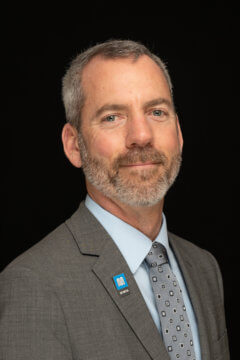
“Downtown San Francisco has one of the lowest office return rates in the country,” said Tumlin. “While the San Francisco economy is very strong, there is a lack of people commuting to offices in downtown.”
While it’s a time of change, Tumlin noted change has been the norm for San Francisco for centuries. The thing about downtown real estate is they’re not making any more of it.
“The bottom line is that San Francisco experiences economic boom-and-collapse cycles and there is no future scenario in which downtown real estate sits empty,” said Tumlin. “The only concern is the length of time it will take to reoccupy downtown office space.”
Tumlin said San Francisco has regularly thrived when thoughtfully planning for its own recovery and investing in mass transit during recessions, referencing the city’s decision to demolish the Embarcadero Freeway in 1991. That decision came after the 1989 earthquake caused major damage to the freeway and city leaders, led by Mayor Art Agnos, made the decision to get rid of the eyesore altogether.
The move made sense, Tumlin said. After a large shakeup to the norm, it’s time to lean into change.
“San Francisco’s strength will never be easy parking or cars,” said Tumlin. “The city’s strength has always been its urbanity, walkability, social mobility and most importantly – its transit.”
Of course, high-speed rail will play a role in San Francisco’s transit system. The California High-Speed Rail Authority is already spending nearly $800 million to electrify Caltrain’s tracks and upgrade the train corridor. When high-speed rail begins service to San Francisco, Tumlin framed the train as a great economic boon to all Californians, not just those who live on the coast.
“We have the chance to equalize opportunity throughout the state,” said Tumlin. “The bulk of innovation that drives economies happen at the intersection of different industries as a result of connections provided by transit.”
What’s Happening in Northern California
APA Award for Diversity and Social Change
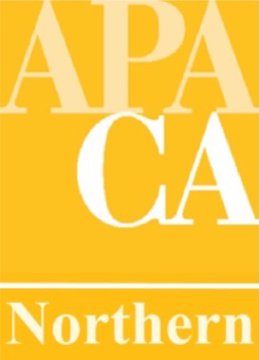 The Authority was honored in April by the American Planning Association (APA) California – Northern Section announcement that the Authority received the 2023 Excellence Award in the category of Advancing Diversity and Social Change in Honor of Paul Davidoff. The recognition is for the San Jose to Merced Project Section, Environmental Justice Community Improvement Planning an Engagement Process. The award is named after Paul Davidoff, an urban planner who pioneered inclusionary zoning.
The Authority was honored in April by the American Planning Association (APA) California – Northern Section announcement that the Authority received the 2023 Excellence Award in the category of Advancing Diversity and Social Change in Honor of Paul Davidoff. The recognition is for the San Jose to Merced Project Section, Environmental Justice Community Improvement Planning an Engagement Process. The award is named after Paul Davidoff, an urban planner who pioneered inclusionary zoning.
“This work reflects a multi-year process of building relationships with the communities that the system travels through, with an emphasis on environmental justice and partnership. We’re honored that the APA recognizes those efforts as a best practice, and we look forward to continuing these relationships as we bring high-speed rail to Northern California,” said Northern California Regional Director Boris Lipkin.
 In planning for the line between San Jose and Merced, the Authority collaborated with environmental justice communities to identify improvements that will help offset project effects. Engagement for the project included over 200 different events, both formal and informal, including 58 meetings focused on planning for community improvements. The collaborative planning approach resulted in the identification of 25 community improvements across the eight affected communities, with the Authority committing to a combined investment of approximately $63 million. The improvements vary, as they reflect the unique needs and interests of each community. They include park improvements, street safety improvements, school/community recreational facilities, supporting school bus routing, pedestrian/bike connections and overpasses, school retrofits, noise insulation to address existing noise impacts and reestablishing a library focused on civil rights at a local African American community center. Read more about this award here.
In planning for the line between San Jose and Merced, the Authority collaborated with environmental justice communities to identify improvements that will help offset project effects. Engagement for the project included over 200 different events, both formal and informal, including 58 meetings focused on planning for community improvements. The collaborative planning approach resulted in the identification of 25 community improvements across the eight affected communities, with the Authority committing to a combined investment of approximately $63 million. The improvements vary, as they reflect the unique needs and interests of each community. They include park improvements, street safety improvements, school/community recreational facilities, supporting school bus routing, pedestrian/bike connections and overpasses, school retrofits, noise insulation to address existing noise impacts and reestablishing a library focused on civil rights at a local African American community center. Read more about this award here.
Building the Future
Governor Newsom announced April 24 a bevy of funding awards that will benefit Bay Area travelers. The awards include $60 million for the Transbay Joint Powers Authority, which is doing advanced design work on The Portal, a 1.4-mile tunnel that will connect Salesforce Transit Center with the existing Caltrain corridor to serve both high-speed rail and Caltrain trains.
Down the peninsula, San Jose was allocated $46.6 million to extend the orange line light rail and connect it to the Milpitas BART station. California Transportation Secretary Toks Omishakin announced the funding in a news conference in San Jose.
“The congested transit-dependent neighborhoods of East San Jose are all classified as low-income communities, and these residents will be able to travel on light rail through some of the Bay Area’s most congested corridors to major regional job centers,” Omishakin said. “This award is part of a historic wave of state funding to expand transit and passenger rail service throughout the state. Helping to improve access to public transportation and cut planet warming pollution.”
Celebrating Earth Day and Green Transportation
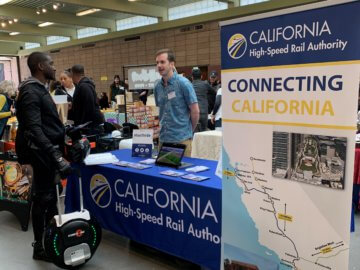 The Earth Day crowd in San Francisco’s Golden Gate Park was diverse. Vendors sold omega superfood oatmeal and kombucha. Sierra Nevada provided a beer garden.
The Earth Day crowd in San Francisco’s Golden Gate Park was diverse. Vendors sold omega superfood oatmeal and kombucha. Sierra Nevada provided a beer garden.
In the middle of the crowd was clean transportation. Caltrans cited its clean water program. The California High-Speed Rail Authority talked to visitors about cleaning the Central Valley air with our 100% green energy solution. And Dylan Fabris, community and public policy manager for San Francisco Transit Riders, offered up small pins to visitors and asked folks to get involved. Public transportation needs public funding, Fabris said.
“We’re urging the governor and Legislature to invest in transit,” Fabris said. “The fact of the matter is that even though ridership patterns have changed, we’re still seeing people are eager and reliant on public transportation. People still love transit.”
The love was evident on Earth Day. Authority staff talked about our green construction efforts. People were happy to hear we’ve reused 93% of our construction materials, keeping them from landfills. The Authority has also preserved and restored thousands of acres of habitat along our route. And of course, our trains themselves are critical to California’s green future. The high-speed rail system is expected to take as much as 2 million metric tons of carbon dioxide out of the air every year, which is equivalent to taking all of the cars registered in San Francisco off the road.
Northern California Videos Win Awards
We are pleased to announce that the Authority won two awards for its Project Section Overview Series. The video series, featuring the San Francisco to San Jose and San Jose to Merced project sections, took first place in the 2023 PRNEWS Digital Awards in the category of Video/Video Series and received an Award of Distinction at the 2023 CAPIO Awards for In-House Video Series Production. The videos highlight environmentally cleared plans for the rail alignment throughout the Northern California section.
Hayward Concrete Expert Goes Green for Rail Project
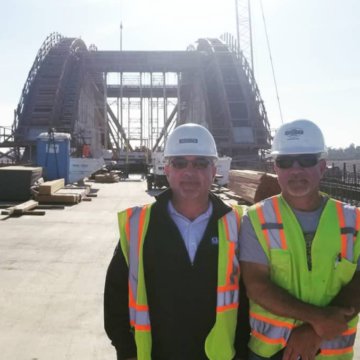 Ted Landavazo doesn’t live close to Madera. But he owns a home there. The company he co-founded, Landavazo Bros., is based in Hayward, the heart of the East Bay. It’s about 150 miles from his business’ location to where the California High-Speed Rail Authority is busily prepping the high-speed rail line in the Central Valley to lay tracks in the next few years.
Ted Landavazo doesn’t live close to Madera. But he owns a home there. The company he co-founded, Landavazo Bros., is based in Hayward, the heart of the East Bay. It’s about 150 miles from his business’ location to where the California High-Speed Rail Authority is busily prepping the high-speed rail line in the Central Valley to lay tracks in the next few years.
If the traffic is good – chuckle at that sentiment, if you like – it takes his workers and equipment about three hours to get down to the project. That’s a lot of time for his team to spend on the road, so Landavazo bought a house in Madera, giving his team a nice place to stay for the night when they’re working on the project.
Landavazo and his workers pour concrete. The small, Latino-owned company handles a variety of work. For the Authority, Landavazo and his team pour walls, beams and anything else that might be needed. He’s worked in the business since 1981, when he was 19 years old. Now with a son working for him and grandchildren in California, Landavazo says the rail project is about much more than connecting the state’s spread-out communities.
“It means a lot. I think it’s great,” he said. “I have a son (Jonathan), he’s 26 years old, working for me now. He’s been with me about 5 years. … We were sitting in a meeting a couple years ago on a hot summer day in downtown Fresno. There were a bunch of guys in the room and not much was going on. My son kicked me and said ‘Why do we do this?’ It’s not for me, it’s not for your mom, but the state does need green stuff and this is obviously a green job.”
 Landavazo would know. He has a front-row seat to a project that has transformed the way California builds infrastructure. For starters, working for the Authority has required Landavazo to use equipment that produces the least amount of greenhouse gasses possible. He replaced all his boom pumps – those extendable arms that reach long distances for big jobs – with the most efficient equipment available.
Landavazo would know. He has a front-row seat to a project that has transformed the way California builds infrastructure. For starters, working for the Authority has required Landavazo to use equipment that produces the least amount of greenhouse gasses possible. He replaced all his boom pumps – those extendable arms that reach long distances for big jobs – with the most efficient equipment available.
Even the cement itself is different. The Authority is using 25% fly ash in its concrete mix, which requires less water and makes the concrete structures stronger and less permeable.
“For me, when we do something like this, it’s for my grandkids,” Landavazo said.
He thinks about his family a lot. Landavazo recently put solar panels on his roof and an electric vehicle charger in his garage because it’s good for the future. And he might retire, one day, and Jonathan will take over the company. The leadership of Landavazo Bros. might change. Thinking about the future will not.
“He’s following the project about as close as I am,” Ted Landavazo said. “I think he’s of the same mindset I am. The state needs to go green, it’s very important for all of us.”
Design Students Use High-Speed Rail Project to Make Connections
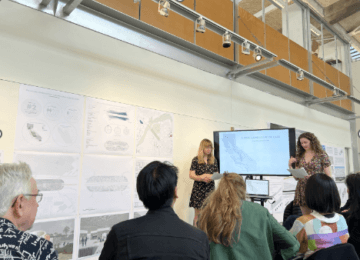 Students statewide are analyzing how high-speed rail will bring Californians together like never before, bridging long-standing gaps between Southern, Central and Northern California.
Students statewide are analyzing how high-speed rail will bring Californians together like never before, bridging long-standing gaps between Southern, Central and Northern California.
The high-speed rail project is already making connections. This spring, architecture students at the California College of the Arts in San Francisco learned about high-speed rail through guest lectures from the Director of Planning and Sustainability and the Northern California Regional Director and a field visit to the heart of construction in California’s Central Valley. The culmination of their class work tackles the side effects of what it means to connect California both physically and socially.
Associate Professor Neeraj Bhatia’s course, “The Territorial City,” is an architecture design-research studio. Bhatia focuses on the potential for high-speed rail to connect once-distant cities and regions.
“This transformation is different than the sprawl produced by highways,” Bhatia said. “This is a paradigm shift in how Americans might live and work and needs to be understood more holistically.” The class focuses on the differences between the Coastal California and Central Valley economies, the changes that are coming and ways to improve life in both regions.
As part of their tour, students did a site visit of the Central Valley Training Center, a workforce development center that provides pre-apprenticeship classes and hands-on construction industry training for Central Valley residents. Hannah Leathers, a student of the design-research studio, recounted the importance of the educational opportunities offered by the Central Valley Training Center in Selma when speaking to construction workers at a construction site tour. The training center gives workers the qualifications they need to start work in the trades.
“[It] was interesting to hear about how many jobs have been created. It’s adding a benefit for them and their community.”
The benefits go well beyond taking passengers from place to place. For their class, the students were primarily interested in tackling problems through the new high-speed rail line. Student Alia Brookshire noted the lack of healthcare facilities while surveying the landscape in the Central Valley.
Leathers and Brookshire were one of five student groups that proposed solutions using high-speed rail to connect the Central Valley. Their project, “A New Landscape of Care,” imagines a high-speed rail-based medical network, envisioning train cars as mobile healthcare facilities that “travels to or with users,” offering therapy, immunizations, breastfeeding rooms and meditation spaces. In presenting the work, the students made the case that high-speed rail solves myriad healthcare problems.
“High-speed rail makes this distributed model possible because it can quickly connect geographically distant things,” Brookshire and Leathers said during a presentation before a jury panel and classmates.
Bhatia said the collaboration with the Authority is key to aiding the students’ understanding of the scale of the project.
“It was really inspiring for the group to see the sites under construction and understand the scale and complexity of the project,” Bhatia said. “… We are very grateful for this opportunity to learn directly from the California High Speed Rail Authority and hope to continue this collaboration.”
This is part of a larger effort by the Authority to connect students to the project through classroom presentations, construction tours, networking, jobs and resources. You can learn more about our student outreach efforts at hsr.ca.gov/i-will-ride.
| UPDATES FROM SOUTHERN CALIFORNIA |
SoCal Outreach is Booming!
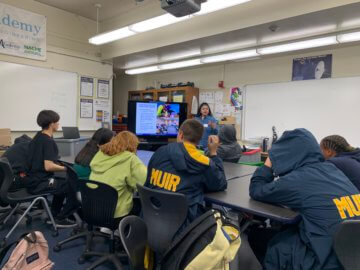 Throughout 2023, the Southern California team has participated in a variety of outreach events and activities throughout the region, connecting with diverse groups of community members, students, and small businesses.
Throughout 2023, the Southern California team has participated in a variety of outreach events and activities throughout the region, connecting with diverse groups of community members, students, and small businesses.
Since in-person outreach resumed in 2022, Southern California staff has worked closely with headquarters to continue to build the Authority’s student engagement program, I Will Ride, in the region. Last year alone, the Southern California outreach team met with over 1,200 students to inform, educate and inspire them through presentations and discussions covering the project, construction progress, and career opportunities with high-speed rail. In February, the I Will Ride program’s year-long outreach efforts with the K-12 Foothill Consortium resulted in a Central Valley Construction tour. 40 students representing the Azusa, Charter Oak, Duarte and Monrovia Unified School Districts were the first group of students from the Southern California region to visit and tour the active construction sites in the Central Valley.
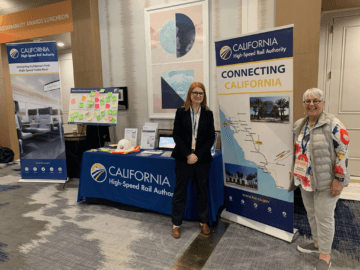 There’s also been more community outreach in Southern California. In May, outreach staff visited the city of Lancaster to participate in their annual Poppy Festival! The team shared project information and provided updates on the Bakersfield to Palmdale segment. Over the course of the event, our team spoke to more than 300 community members from the Antelope Valley.
There’s also been more community outreach in Southern California. In May, outreach staff visited the city of Lancaster to participate in their annual Poppy Festival! The team shared project information and provided updates on the Bakersfield to Palmdale segment. Over the course of the event, our team spoke to more than 300 community members from the Antelope Valley.
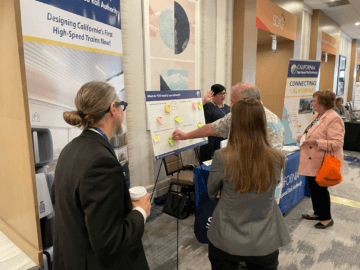 Outside of student and community outreach, the Southern California team has participated in a variety of conferences and professional events in the region. Recently, the Southern California team staffed and sponsored outreach booths at MOVE LA’s Community Conversation conference in Downtown Los Angeles, and the Southern California Association of Governments (SCAG) Regional Conference and General Assembly in Palm Desert. Authority staff and directors spoke with elected officials and policymakers about the high-speed rail project’s progress and the benefits it provides to the State and their communities. Booth visitors at both events expressed their excitement and interest in the project and shared what they’d like to experience on our trains, with a common interest in ticket affordability, modern technology, onboard amenities and for pet lovers – dog access.
Outside of student and community outreach, the Southern California team has participated in a variety of conferences and professional events in the region. Recently, the Southern California team staffed and sponsored outreach booths at MOVE LA’s Community Conversation conference in Downtown Los Angeles, and the Southern California Association of Governments (SCAG) Regional Conference and General Assembly in Palm Desert. Authority staff and directors spoke with elected officials and policymakers about the high-speed rail project’s progress and the benefits it provides to the State and their communities. Booth visitors at both events expressed their excitement and interest in the project and shared what they’d like to experience on our trains, with a common interest in ticket affordability, modern technology, onboard amenities and for pet lovers – dog access.
As we near the midway point of 2023, the Southern California team is excited to discover more outreach opportunities, staff more events, and continue to inform our region about high-speed rail in the second half of the year.
Southern California Project Update to the CMAA Southern California Chapter
 In May, Southern California Regional Director LaDonna DiCamillo presented virtually to members of the Construction Management Association of America (CMAA) Southern California chapter. CMAA is an industry association dedicated to the practice of professional construction management, representing more than 16,000 members with the common goal of improving our nation’s infrastructure. LaDonna presented members with a statewide and Southern California overview, covering economic benefits, connectivity with other transportation services and an overview of the Palmdale Station planning process. Additionally, members were provided with a recap of progress made in 2022, while looking ahead towards upcoming milestones and the Authority’s pursuit of project funding.
In May, Southern California Regional Director LaDonna DiCamillo presented virtually to members of the Construction Management Association of America (CMAA) Southern California chapter. CMAA is an industry association dedicated to the practice of professional construction management, representing more than 16,000 members with the common goal of improving our nation’s infrastructure. LaDonna presented members with a statewide and Southern California overview, covering economic benefits, connectivity with other transportation services and an overview of the Palmdale Station planning process. Additionally, members were provided with a recap of progress made in 2022, while looking ahead towards upcoming milestones and the Authority’s pursuit of project funding.
Reaching UCLA Bruins
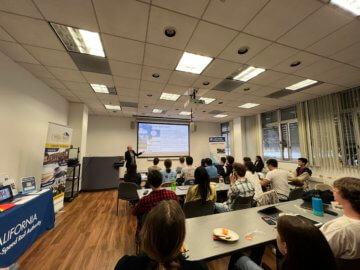
 In April, the Authority joined the UCLA Institute of Transportation Engineers (ITE) student group. While we’ve done work with other southern California colleges, this marked our first time at a major Southern California university outreach event. Keynote speakers for the event were Southern California Regional Director LaDonna DiCamillo and Regional Delivery Manager Noopur Jain. LaDonna provided a statewide and Southern California update and Noopur discussed some of the major engineering challenges in the Southern California region. Southern California PIO Crystal Royval and Student Outreach Specialist Yaqeline Castro also joined the event to support with event logistics and answer questions about the I Will Ride program. UCLA ITE students noted that this was their highest attended event with 30 students. The Authority is proud to have offered our inaugural sponsorship to the UCLA ITE for the Spring 2023 quarter. Go Bruins!
In April, the Authority joined the UCLA Institute of Transportation Engineers (ITE) student group. While we’ve done work with other southern California colleges, this marked our first time at a major Southern California university outreach event. Keynote speakers for the event were Southern California Regional Director LaDonna DiCamillo and Regional Delivery Manager Noopur Jain. LaDonna provided a statewide and Southern California update and Noopur discussed some of the major engineering challenges in the Southern California region. Southern California PIO Crystal Royval and Student Outreach Specialist Yaqeline Castro also joined the event to support with event logistics and answer questions about the I Will Ride program. UCLA ITE students noted that this was their highest attended event with 30 students. The Authority is proud to have offered our inaugural sponsorship to the UCLA ITE for the Spring 2023 quarter. Go Bruins!
Southern California Small Business Providing Engineering Expertise to High-Speed Rail
 IDC Consulting Engineers (IDC), based in sunny Southern California, has contributed its engineering expertise to various infrastructure projects across California. From our very own California High-Speed Rail project to Link US at Union Station, all the way to Bay for a pair of seismic bridge projects.
IDC Consulting Engineers (IDC), based in sunny Southern California, has contributed its engineering expertise to various infrastructure projects across California. From our very own California High-Speed Rail project to Link US at Union Station, all the way to Bay for a pair of seismic bridge projects.
Founded in 1995 by Dr. Xiaoyun Wu, IDC came to life after Wu’s seismic engineering knowledge and contributions led to the creation of China’s seismic design standards. This experience opened the path to a full Ph.D. scholarship to study earthquake engineering at the University of Southern California. Following Wu’s Ph.D., Caltrans initiated a statewide bridge seismic program in the aftermath of the Loma Prieta earthquake. The program’s strong demand for bridge engineers with knowledge and background in earthquake engineering took Wu to Northern California to work on the seismic assessments and retrofits for the Richmond-San Rafael Toll Bridge and the San Francisco Bay Bridge replacement projects. These complex bridge engineering projects kindled her passion and purpose for engineering and life, leading Wu to establish IDC Consulting Engineers – and making the United States her home.
Read more about Wu’s journey from China to graduating a Trojan and founding IDC in the Spring 2023 Small Business Newsletter.
Frequently Asked Questions
Does high-speed rail actually cause more pollution than it saves?
No. The benefits of the project are significant. For construction, we are setting the bar on how to build infrastructure in a sustainable way. Construction vehicles must be the most efficient available. Site emissions are 60% lower than is typical around the state. When we start carrying passengers, the environmental benefits are incredibly high, taking nearly 400,000 vehicles off the road annually when we’re in full operations. The effect will be cleaner air for all Californians, but particularly in the Central Valley, which has among the worst air quality in the nation.
Has high-speed rail created new jobs for people?
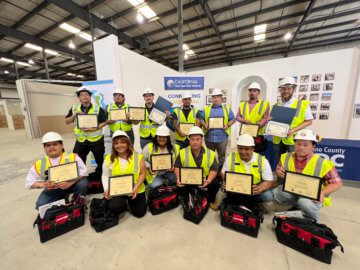 Yes! To date, more than 10,000 construction jobs have been created since the start of the project, with a majority of those going to residents of the Central Valley. There are more than 30 active construction sites in California’s Central Valley along roughly 119 miles. In the Central Valley, the Authority is partnering with the City of Selma, the Fresno Economic Development Corporation, the Fresno, Madera, Kings, Tulare Building Trades Council, and the Fresno Economic Opportunities Commission to offer a 12-week pre-apprenticeship program aimed at serving veterans, at-risk young adults, minority and low-income populations in the Central Valley. This no-cost program provides hands-on construction industry training for those looking to work on the nation’s first high-speed rail project. In fact, in April, 14 students completed the training program as its most recent graduation class. Learn more about this program.
Yes! To date, more than 10,000 construction jobs have been created since the start of the project, with a majority of those going to residents of the Central Valley. There are more than 30 active construction sites in California’s Central Valley along roughly 119 miles. In the Central Valley, the Authority is partnering with the City of Selma, the Fresno Economic Development Corporation, the Fresno, Madera, Kings, Tulare Building Trades Council, and the Fresno Economic Opportunities Commission to offer a 12-week pre-apprenticeship program aimed at serving veterans, at-risk young adults, minority and low-income populations in the Central Valley. This no-cost program provides hands-on construction industry training for those looking to work on the nation’s first high-speed rail project. In fact, in April, 14 students completed the training program as its most recent graduation class. Learn more about this program.
Upcoming Events
Viva Calle SJ
June 11
10 a.m. to 3 p.m.
San Jose’s premier open streets event invites everybody to walk, skate and bike through the streets of town on a sunny Sunday. Authority staff will be on hand at a hub to talk about our project. Click here for more information.
North Beach Festival
June 17-18
10 a.m. to 3 p.m.
Local artisans, performance groups and delicious food will all converge in San Francisco for the 67th annual North Beach Festival. Authority staff will be available to talk about our project. Click here for more information.
SF Pride Parade
June 25
Time: TBA
Authority staff will be at the corner of 4th and King streets – San Francisco Station – to talk about the project at one of the largest Pride celebrations in the world. Click here for more information.
San Rafael Farmers’ Market
July 6
5:30 p.m. to 8:30 p.m.
Authority staff will be at the San Rafael Farmers’ Market. Stop by to stock up on fresh produce and talk with us about high-speed rail. Click here for more information.
Redwood City Music on the Square
July 28
6 p.m. to 8 p.m.
We’ll be on hand to listen to a free concert and talk about our project. Drop by Courthouse Square to learn more. Click here for more information.



